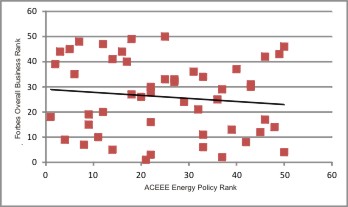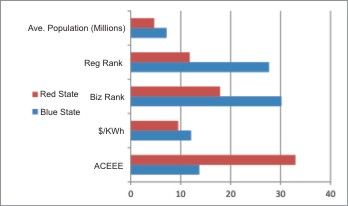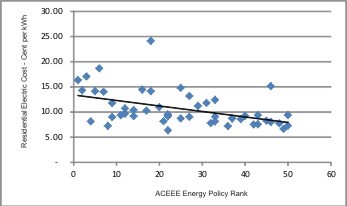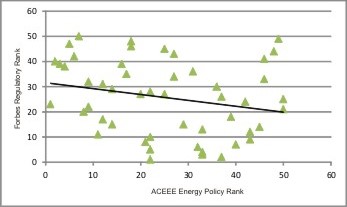
I recently read an article from a management consulting firm regarding what not to do when using social media for marketing. First on the list: don’t talk about politics. So what does Jeff do? Fly right into the storm. Politics and energy efficiency are directly linked in regulated utility markets in which we live, so this is an obvious critical subject.
Recently, the National Academy of Sciences released a report, “Political Ideology Affects Energy-Efficiency Attitudes and Choices”. One of the main points talks about environmental benefits and CO2 reductions as a benefit to buying energy efficient products, and it is a big downer for conservatives. This would be exactly like a Packer fan finally being able to afford a craved Ford F150 pickup truck to then find F150s become the official truck of the Minnesota Vikings, and so he doesn’t buy it – wouldn’t want to be caught dead driving, or I guess being driven around in, the official truck of the Minnesota Vikings.
In politics, particularly political parties, there is excessive blind allegiance. Blind allegiance is described in the paragraph above. This creates major roadblocks to fixing problems. Consider immigration. Hard core conservatives are staunchly against “amnesty” for illegals. What is the alternative? Going door to door like the Gestapo, rounding them up like cattle and shipping them back to Mexico? That is entirely unrealistic. Similarly, the hard left insists that all of our power come from solar, wind, and bacon grease – check that, tofurkey grease. This, too, is entirely unrealistic.
Effective problem solvers are realistic people. Solving any problem starts with effectively setting the boundaries of what is realistically possible. This applies to both energy savings calculations and solving real-world problems that involve the masses of people. The limits on saving energy start with the utility bills and from there move into the end-use analysis. I.e., savings from lighting measures cannot exceed the estimated allocation of electricity consumed by lighting. The limits of getting everything you want when other people are involved: 0%. Odds of making everyone happy and not going broke while doing so: 0.00%
Politics are a substantial reason for why I do not support mandates for unequal[1] products such as compact fluorescent bulbs versus incandescent bulbs. Unnecessary mandates jerk the chains of the folks who want to ship the “illegals” back to their country of origin. It is counter productive. In a stroke of irony, the CFL mandate was signed into law by GW Bush. I think it’s pretty safe to say supporters of president Obama despised Mr. Bush while many support this mandate and want more mandates.
Then there is this report that claims people in red states consume 55% more energy per capita than citizens of blue states. I have not studied the underlying details, but what I would mention is that red states are generally less densely populated and industry-friendlier. Does it not make sense that Houston, with 4000 square miles[2] of refineries, consumes more energy per capita than Chicago, which manufactures… I can’t think of anything manufactured in Chicago or New York. For example, the once booming industrial upstate area of Buffalo and Niagara Falls gives new meaning to the term rust belt.
Then there is this article that states, “carbon emissions are much higher than energy consumption in Red states”. My blood pressure is lower than my daily intake of calories too.
Another thing to guard against when reading research results is spin. Far (far, far far) too much research is conducted to find data that paints the conclusion that wants to be “discovered”. Problems are much better solved by avoiding emotion, bias, and ideology.
On that note, I conducted my own research of red states versus blue states (Figure 1) [3]. The story goes that blue states have better energy efficiency policy. I wonder, are they also more highly regulated, business unfriendly, with higher energy costs? Sources: ACEEE for energy efficiency ranking and; Forbes for business climate.
The results are weighted for populations of the states. I.e., it doesn’t make sense to count energy cost for California into blue state averages and for North Dakota into red state averages, equally.
Forbes includes economic climate, regulation, quality of life and other junk in their “Biz Rank”[4]. “Reg Rank” is their regulatory ranking. Keep in mind that lower is better for rankings.
Next, I looked at electricity cost versus ACEEE’s energy policy ranking (Figure 2). That is followed by regulatory ranking[5] and overall business ranking versus ACEEE’s scores (Figure 3). What I found versus what I expected: flatter lines. To my surprise, electricity costs in the south and mid south are higher than I expected at about 9.5 cents per kWh. The regulatory ranks are all over the place. Surprisingly, states like Wyoming, West Virginia and New Hampshire (Live free or die? Really?) ranked horribly from a regulatory perspective.
Red states that are best for business and have decent energy policy are North Carolina, Texas, and Utah (Figure 4). Top blue states include Massachusetts, Colorado, Virginia, and Washington. Congratulations!









